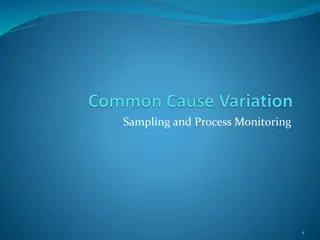Insights on Quality Control Techniques for Process Variation
Explore quality control strategies such as X-bar and R charts, limits for detecting common and special causes, and the similarity between hypothesis testing and quality control in maintaining process consistency and identifying variations. Learn key principles for creating effective charts and interpreting data for effective decision-making.
Download Presentation

Please find below an Image/Link to download the presentation.
The content on the website is provided AS IS for your information and personal use only. It may not be sold, licensed, or shared on other websites without obtaining consent from the author.If you encounter any issues during the download, it is possible that the publisher has removed the file from their server.
You are allowed to download the files provided on this website for personal or commercial use, subject to the condition that they are used lawfully. All files are the property of their respective owners.
The content on the website is provided AS IS for your information and personal use only. It may not be sold, licensed, or shared on other websites without obtaining consent from the author.
E N D
Presentation Transcript
Data on part thickness Thickness of parts recorded as amount by which thickness exceeded 0.300 in. (everyone else has gone metric but ..) 2
Data structure Sample Value 1 1 1 4 1 6 1 4 2 3 2 7 2 5 2 5 3 4 3 5 3 5 3 7, etc. 3
Raw data plot, thickness vs sample number 4
Table 3.2 constants for X-bar and R charts 5
Limits are designed to . Make sure that the operator does not react to Common cause. Indicate when you are reasonably sure that Special Cause is present. If only Common Cause is present in the process, then the chance of a false signal is about 1%, i.e. the probability that the chart will falsely indicate the presence of Special Cause is about 0.01. 8
Similar to Hypothesis Testing In hypothesis testing we say there is a treatment difference if p<alpha=0.05 (usually). The chance of falsely declaring a treatment difference exists is then about 1 out of 20. In Quality Control, we use the 1 out of 100 criteria to say that our process has more variation than just Common Cause (idea due to Shewhart, it is simple but effective in practice). 9
R-chart and Common Cause If the data in each subgroup was collected under homogeneous conditions , then the Ranges should reflect only Common Cause. The chart should not indicate the presence of Special Cause. If no signal of Special Cause is indicated, this is not proof that within subgroup variation is only due to Common Cause. (More on this later in Rational Subgrouping.) 10
R chart 11
X-bar chart and Special Cause If the R-chart is in control, i.e., stable and predictable, then any shifts in the mean of the process come from Special Cause. If the X-bar chart indicates the process is out of control , i.e., that Special Cause is present. We then use a fishbone diagram (or detailed Cause and Effect Matrix) to try to identify and remove the source of Special Cause. 12
X-bar chart 13























